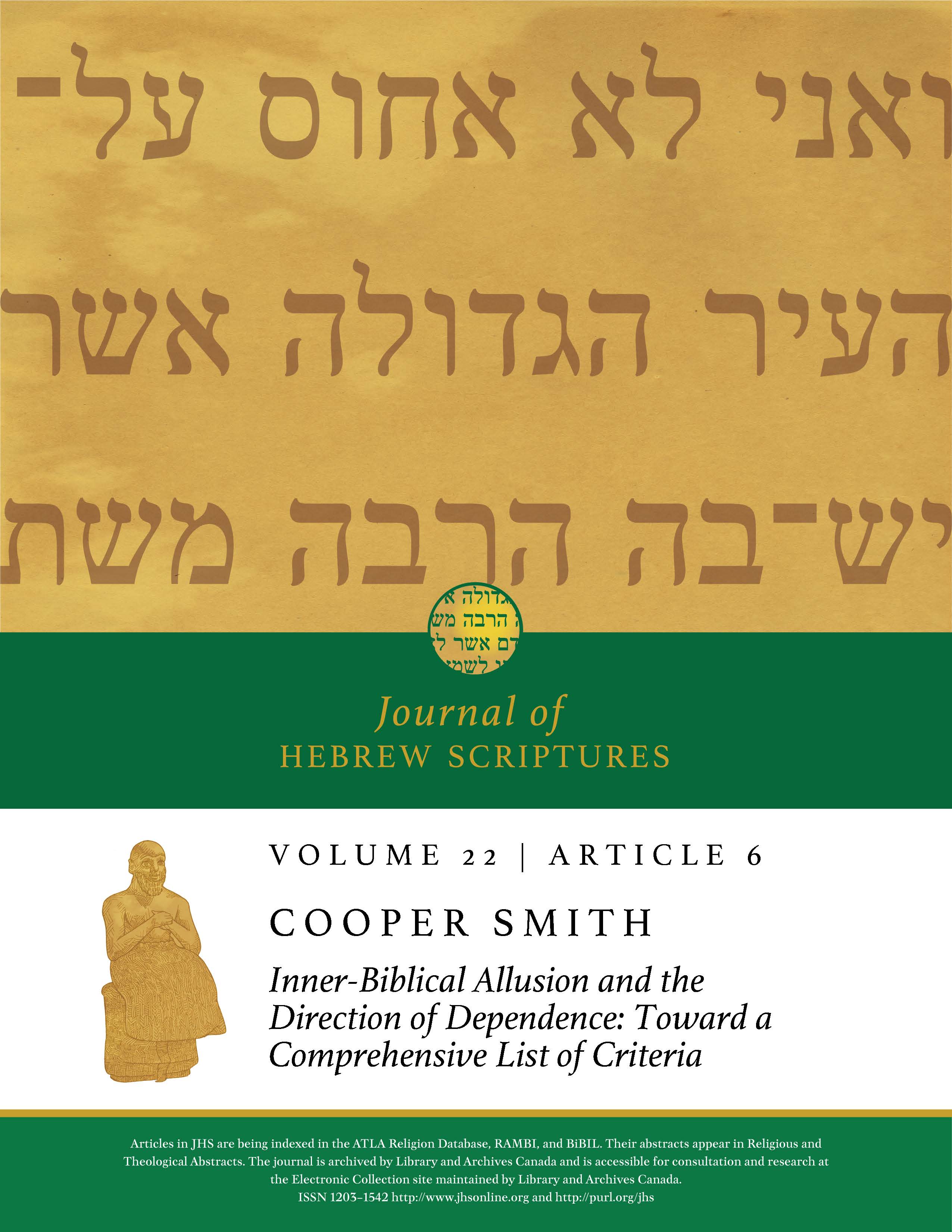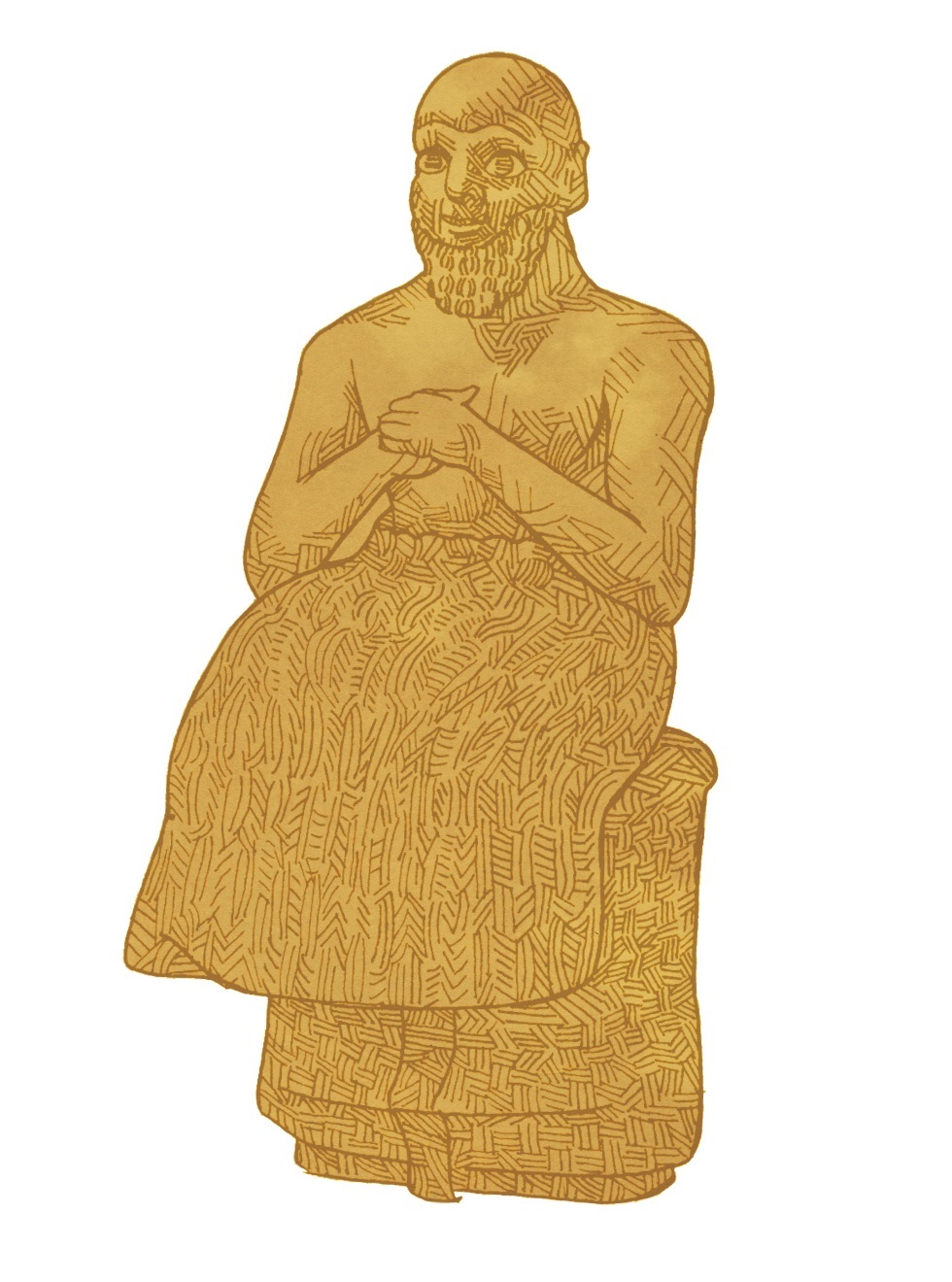Inner-Biblical Allusion and the Direction of Dependence: Toward a Comprehensive List of Criteria
DOI:
https://doi.org/10.5508/jhs29632Keywords:
Old Testament, Hebrew Bible, intertextuality, borrowing, method, methodology, Isaiah, innerbiblical, inner biblical, TanakhAbstract
A prevailing need in biblical studies is a comprehensive set of valid arguments for determining the direction of dependence once a literary relationship between two texts in the Hebrew Bible is reasonably established. This study takes a step toward addressing this lacuna by inductively cataloguing, illustrating, and evaluating eight criteria used to substantiate a proposed direction of borrowing in cases of inner-biblical allusion in Isaianic scholarship. These criteria provide a working list of plausible arguments that can be used when claiming the direction of influence in other cases of inner-biblical allusion throughout the Hebrew Bible. Such a list encourages both methodological clarity due to the increased precision of defined categories and scholarly creativity by suggesting multiple viable means to argue for the direction of dependence.
References
Abernethy, Andrew and Wilson Cunha, eds., Isaiah and Intertextuality. Forschungen zum Alten Testament 2. Reihe. Tübingen: Mohr Siebeck, forthcoming.
Ackroyd, Peter R. “Hosea and Jacob.” Vetus Testamentum 13 (1963): 245–59.
Anderson, Joel Edmund and P. M. Venter. “Isaiah 36–39: Rethinking the Issues of Priority and Historical Reliability.” Harvard Theological Studies 65 (2009): 50–54.
Ben-Porat, Ziva. “The Poetics of Literary Allusion.” PTL: A Journal for Descriptive Poetics and Theory of Literature 1 (1978): 105–28.
Berger, Yitzhak. “Ruth and Inner-Biblical Allusion: The Case of 1 Samuel 25.” Journal for Biblical Literature 128 (2009): 253–72.
Bergey, Ronald. “The Song of Moses (Deuteronomy 32:1–43) and Isaianic Prophecies: A Case of Early Intertextuality?” Journal for the Study of the Old Testament 28 (2003): 33–54.
Blum, Erhard “Noch Einmal Jakobs Traum in Bethel—Genesis 28, 10–22.” Pages 33–54 in Rethinking the Foundations: Historiography in the Ancient World and in the Bible. Edited by Steven McKenzie and Thomas Römer. Beiheft zur Zeitschrift für die alttestamentliche Wissenschaft 294. New York: de Gruyter, 2000.
Boda, Mark J. and Michael H. Floyd, eds. Bringing Out the Treasure: Inner Biblical Allusion in Zechariah 9–14. Journal for the Study of the Old Testament: Supplement Series 370. Sheffield: Sheffield Academic, 2003.
Bosshard-Nepustil, Erich. Rezeptionen von Jesaia 1–39 im Zwölfprophetenbuch: Untersuchungen zur literarischen Verbindung von Prophetenbüchern in babylonischer und persischer Zeit. Orbis biblicus et orientalis 78. Göttingen: Vandenhoeck & Ruprecht, 1997.
Brinks, Christina. “Job and Deutero Isaiah: The Use and Abuse of Traditions.” Biblical Interpretation 20 (2012): 407–20.
Carr, David. “Method in Determination of Direction of Dependence: An Empirical Test of Criteria Applied to Exodus 34,11–26 and Its Parallels.” Pages 107–40 in Gottes Volk am Sinai: Untersuchungen zu Ex 32–34 und Dtn 9–10. Edited by Matthias Köckert and Erhard Blum. Veröfffentlichungen der Wissenschaftlichen Gesellschaft für Theologie 18. Gütersloh, Germany: Chr. Kaiser, 2001.
Carr, David. The Formation of the Hebrew Bible: A New Reconstruction. New York: Oxford University Press, 2011.
Curtis, John. “Elihu and Deutero-Isaiah: A Study in Literary Dependence,” Proceedings 10 (1990): 31–38.
Day, John. “A Case of Inner Scripture Interpretation: The Dependence of Isaiah 26:13–27:11 on Hosea 8:4–9:10 (Eng. 9) and Its Relevance to Some Theories of the Redaction of the ‘Isaiah Apocalypse’.” Journal for Theological Studies 31 (1980): 309–19.
Driver, S. R. An Introduction to the Literature of the Old Testament. 6th ed. New York: Charles Scribner’s Sons, 1897.
Eslinger, Lyle. “Inner-Biblical Exegesis and Inner-Biblical Allusion: The Question of Category,” Vetus Testamentum 42 (1992): 47–58.
Fishbane, Michael. Biblical Interpretation in Ancient Israel. Oxford: Clarendon Press, 1985.
Gesundheit, Shimon. “The Strengths and Weaknesses of Linguistic Dating.” Pages 295–302 in The Formation of the Pentateuch: Bridging the Academic Cultures of Europe, Israel, and North America. Edited by Jan Gerts, et. al. Forschungen zum Alten Testament 111. Tübingen: Mohr Siebeck, 2016.
Gosse, Bernard. Isaïe 13,1–14,23: Dans la Tradition Littéraire du Livre d’Isaïe et dans la Tradition des Oracles contre les Nations. Orbis biblicus et orientalis 78. Göttingen: Vandenhoeck & Ruprecht, 1988.
Groenewald, Alphonso. “Isaiah 1:2–3, Ethics and Wisdom. Isaiah 1:2–3 and the Song of Moses (Dt 32): Is Isaiah a Prophet Like Moses?” Harvard Theological Studies 67 (2011): 1–6.
Gross, Carl. “Literary Allusions in Isaiah: Isaiah 44:28–45:13 Revisited,” The Bible Translator 54 (2003): 317–25.
Halpern, Baruch. “The Resourceful Israelite Historian: The Song of Deborah and Israelite Historiography.” Harvard Theological Review 76 (1983): 379–401.
Halpern, Baruch. “The New Names of Isaiah 62:4: Jeremiah’s Reception in the Restoration and Politics of ‘Third Isaiah’.” Journal of Biblical Literature 117 (1998): 623–43.
Harvey, John. Retelling the Torah: The Deuteronomistic Historian’s Use of Tetrateuchal Narratives. Library of Hebrew Bible/Old Testament Studies 403. New York: Bloomsbury, 2004.
Irwin, William “What Is an Allusion?” Journal for Aesthetics and Art Criticism 59 (2001): 287–97.
Jarvis, Robin. Wordsworth, Milton, and the Theory of Poetic Relations. New York: St. Martin’s Press, 1991.
Juvan, Marko. History and Poetics of Intertextuality. Translated by Timothy Pogačar. West Lafayette, IN: Purdue University, 2008.
Kaiser, Otto. Isaiah 13–39. Translated by R. A. Wilson. Old Testament Library. Philadelphia: Westminster Press, 1974.
Keiser, Thomas A. “The Song of Moses a Basis for Isaiah’s Prophecy,” Vetus Testamentum 55 (2005): 486–500.
Kelly, Joseph “Identifying Literary Allusions: Theory and the Criterion of Shared Language.” Pages 22–40 in Subtle Citation, Allusion, and Translation in the Hebrew Bible. Edited by Ziony Zevit. Sheffield: Equinox, 2017.
Kiesow, Klaus. Exodustexte im Jesajabuch: Literarkritische und Motivgeschichtliche Analysen. Orbis biblicus et orientalis 24. Göttingen: Vandenhoeck & Ruprecht, 1979.
Kline, Jonathan. Allusive Soundplay in the Hebrew Bible, Society of Biblical Literature Ancient Israel and its Literature. Atlanta: SBL Press, 2016.
Krause, Joachim. Exodus und Eisodus: Komposition und Theologie von Josua 1–5. Supplements to Vetus Testamentum 161. Leiden: Brill, 2014.
Krause, Joachim. “Citations, Allusions, and Marking them in the Hebrew Bible: A Theoretical Introduction with Some Examples.” Biblical Interpretation 31 (2023; in press).
Kwon, Jiseong James. Scribal Culture and Intertextuality. Forschungen zum Alten Testament 2. Reihe. 85. Tübingen: Mohr Siebeck, 2016.
Kwon, Jiseong James. “Re-examining the Torah in the Book of Isaiah.” Revue Biblique 126 (2019): 547–64.
Kynes, Will. My Psalm Has Turned into Weeping: Job’s Dialogue with the Psalms. Beiheft zur Zeitschrift für die alttestamentliche Wissenschaft 437. Berlin: de Gruyter, 2012.
Kynes, Will. “Job and Isaiah 40–55: Intertextualities in Dialogue.” Pages 94–105 in Reading Job Intertextually. Edited by Katharine Dell and Will Kynes. Library of Hebrew Bible/Old Testament Studies 574. New York: T&T Clark, 2013.
Leonard, Jeffery. “Identifying Inner-Biblical Allusions: Psalm 78 as a Test Case.” Journal of Biblical Literature 127 (2008): 241–65.
Leonard, Jeffery. “Identifying Subtle Allusions: The Promise of Narrative Tracking.” Pages 91–113 in Subtle Citation, Allusion, and Translation in the Hebrew Bible. Edited by Ziony Zevit. Sheffield: Equinox, 2017.
Lester, G. Brooke. “Inner-Biblical Allusion.” Theological Librarianship 2 (2009): 89–93.
Lyons, Michael. “Marking Innerbiblical Allusion in the Book of Ezekiel.” Biblica 88 (2007): 245–50.
Lyons, Michael. From Law to Prophecy: Ezekiel’s Use of the Holiness Code. New York: T&T Clark, 2009.
Lyons, Michael. “How Have We Changed? Older and Newer Arguments about the Relationship between Ezekiel and the Holiness Code.” Pages 1055–74 in The Formation of the Pentateuch: Bridging the Academic Cultures of Europe, Israel, and North America. Edited by Jan Gerts, et. al. Forschungen zum Alten Testament 111. Tübingen: Mohr Siebeck, 2016.
Machacek, Gregory “Allusion,” Publications of the Modern Language Association 122 (2007): 522–36.
McKenzie, Steven L. “The Jacob Tradition in Hosea 12:4–5.” Vetus Testamentum 36 (1986): 311–22.
Miller, Geoffrey. “Intertextuality in Old Testament Research,” Currents in Biblical Research 9 (2011): 283–309.
Nihan, Christophe. “Ezekiel and the Holiness Legislation: A Plea for Nonlinear Models.” Pages 1015–39 in The Formation of the Pentateuch: Bridging the Academic Cultures of Europe, Israel, and North America. Edited by Jan Gerts, et. al. Forschungen zum Alten Testament 111. Tübingen: Mohr Siebeck, 2016.
Noble, Paul. “Esau, Tamar, and Joseph: Criteria for Identifying Inner-Biblical Allusions,” Vetus Testamentum 52 (2002): 219–52.
Nurmela, Risto. The Mouth of the Lord Has Spoken: Inner-Biblical Allusions in Second and Third Isaiah. Studies in Judaism. Lanham, MD: University Press of America, 2006.
Perri, Carmela. “On Alluding.” Poetics 7 (1978): 289–307.
Riffaterre, Michael. “Interpretation and Undecidability.” New Literary History 12 (1981): 227–42.
Rudman, Dominic. “Zechariah 8:20–22 & Isaiah 2:2–4//Micah 4:2–3.” Biblische Notizen 107/108 (2001): 50–54.
Schultz, Richard. The Search for Quotation: Verbal Parallels in the Prophets. Journal for the Study of the Old Testament: Supplement Series 180. Sheffield: Sheffield Academic, 1999.
Schultz, Richard. “Isaianic Intertextuality and Intratextuality as Composition-Historical Indicators: Methodological Challenges in Determining Literary Influence.” Pages 33–64 in Bind Up the Testimony: Explorations in the Genesis of the Book of Isaiah. Edited by Daniel I. Block and Richard L. Schultz. Peabody, MA: Hendrickson, 2015.
Schnittjer, Gary. Old Testament Use of the Old Testament. Grand Rapids: Zondervan, 2021.
Smith, Cooper “The ‘Wilderness’ in Hosea and Deuteronomy: A Case of Thematic Reappropriation,” Bulletin for Biblical Research 28 (2018): 240–60.
Smith, Cooper. Allusive and Elusive: Allusion and the Elihu Speeches of Job. Biblical Interpretation Series 198. Brill: Boston, 2022.
Sommer, Benjamin. “Exegesis, Allusion and Intertextuality in the Hebrew Bible: A Response to Lyle Eslinger,” Vetus Testamentum 46 (1996), 479–89.
Sommer, Benjamin. A Prophet Reads Scripture: Allusion in Isaiah 40–66. Contraversions. Stanford: Stanford University Press, 1998.
Spawn, Kevin L. ‘As It is Written’ and Other Citation Formulae in the Old Testament: Their Use, Development, Syntax, and Significance. Beiheft zur Zeitschrift für die alttestamentliche Wissenschaft 311. Berlin: de Gruyter, 2002.
Stead, Michael R. The Intertextuality of Zechariah 1–8. Library of Hebrew Bible/Old Testament Studies 506. New York: T&T Clark, 2009.
Sweeney, Marvin. “Hosea’s Reading of Pentateuchal Narratives: A Window for a Foundational E Stratum.” Pages 851–71 in The Formation of the Pentateuch: Bridging the Academic Cultures of Europe, Israel, and North America. Edited by Jan Gerts, et. al. Forschungen zum Alten Testament 111. Tübingen: Mohr Siebeck, 2016.
Terrien, Samuel. “Quelques remarques sur les affinités de Job avec le Deutéro-Esaïe.” Supplements to Vetus Testamentum 15 (1966): 295–310.
Tiemeyer, Lena-Sofia. “Two Prophets, Two Laments and Two Ways of Dealing with Earlier Texts.” Pages 185–204 in Die Textualisierung der Religion. Edited by Joachim Schaper. Forschungen zum Alten Testament 62. Tübingen: Mohr Siebeck, 2009.
Tooman, William. Gog of Magog: Reuse of Scripture and Compositional Technique in Ezekiel 38–39. Forschungen zum Alten Testament 2. Reihe. 52. Tübingen: Mohr Siebeck, 2011.
Tull Willey, Patricia. Remember the Former Things: The Recollection of Previous Texts in Second Isaiah, Society of Biblical Literature Dissertation Series 161. Atlanta: Scholars Press, 1997.
Vang, Carsten. “Inner-Biblical Quotations in Old Testament Narratives: Some Methodological Considerations (e.g., 1 Sam 15:2 and Deut 25:17–19).” Old Testament Essays 33 (2020): 515–37.
Whitt, William D. “The Jacob Traditions in Hosea and Their Relation to Genesis.” Zeitschrift für die alttestamentliche Wissenshaft 103 (1991): 18–43.
Whybray, Norman. Isaiah 40–66. The New Century Bible Commentary. Grand Rapids: Eerdmans, 1981.
Wildberger, Hans. Isaiah 13–27. Translated by Thomas Trapp. Continental Commentaries. Minneapolis: Fortress Press, 1997.
Williamson, Hugh. The Book Called Isaiah: Deutero-Isaiah’s Role in Composition and Redaction. Oxford: Oxford University Press, 1994.
Zevit, Ziony, “Echoes of Texts Past.” Pages 1–21 in Subtle Citation, Allusion, and Translation in the Hebrew Bible. Edited by Ziony Zevit. Sheffield: Equinox, 2001.
Zobel, Konstantin. Prophetie und Deuteronomium: Die Rezeption prophetischer Theologie durch das Deuteronomium. Beiheft zur Zeitschrift für die alttestamentliche Wissenschaft 199. Berlin: de Gruyter, 1992.

Downloads
Published
How to Cite
Issue
Section
License
Copyright (c) 2023 Cooper Smith

This work is licensed under a Creative Commons Attribution 4.0 International License.

 Statue of Ebih-Il, drawing by Simeon Goa, © Journal of Hebrew Scriptures
Statue of Ebih-Il, drawing by Simeon Goa, © Journal of Hebrew Scriptures
